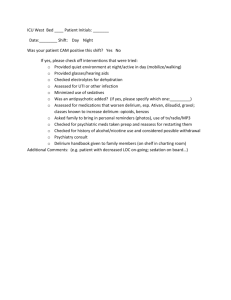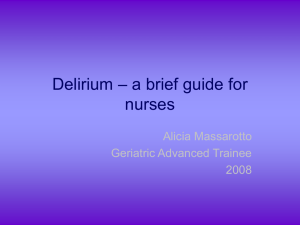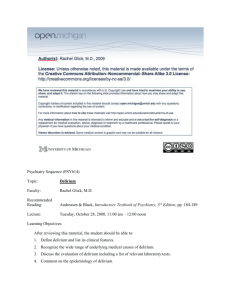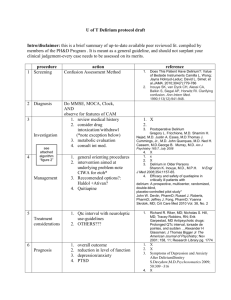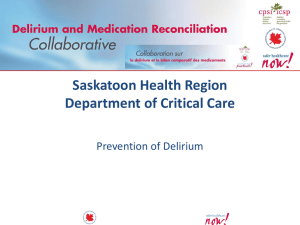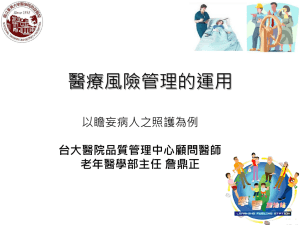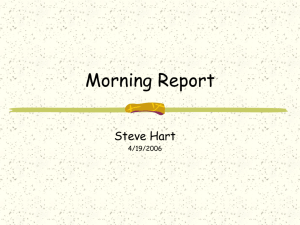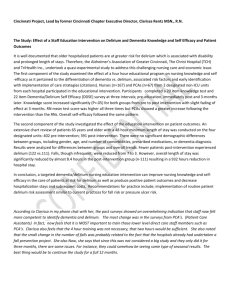Lessons Learned
advertisement
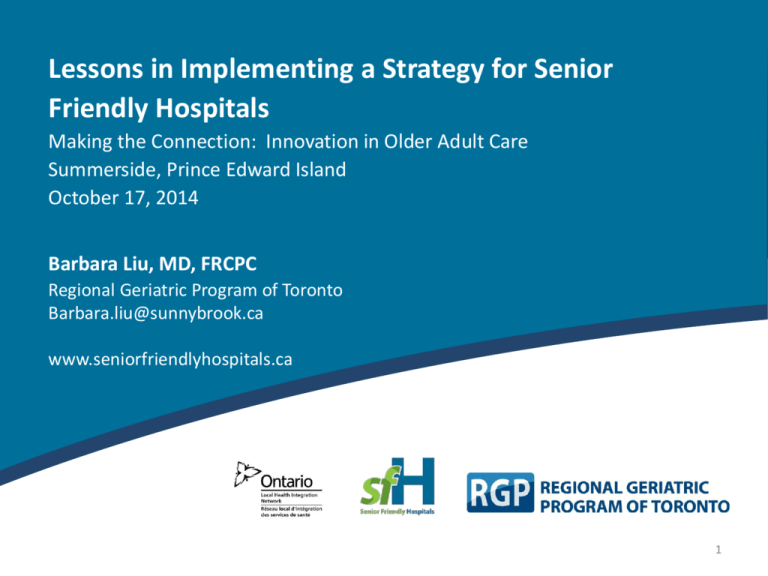
Lessons in Implementing a Strategy for Senior Friendly Hospitals Making the Connection: Innovation in Older Adult Care Summerside, Prince Edward Island October 17, 2014 Barbara Liu, MD, FRCPC Regional Geriatric Program of Toronto Barbara.liu@sunnybrook.ca www.seniorfriendlyhospitals.ca 1 Outline Regional Geriatric Program & SFH framework Ontario Senior Friendly Hospital Strategy – Priority setting, toolkit, indicators Examples of implementation – Early mobilization – MOVE ON – Delirium prevention and management Lessons learned 2 Lessons Learned Alignment + competing priorities Early wins versus mid to long term sustainability Top-down versus bottom-up Hospitals are complex systems – Standardization in the local context Basic ≠ simple 3 Senior Friendly Hospitals in Ontario 4 Regional Geriatric Program of Toronto • • • • Network of 27 hospitals in GTA Better health outcomes for frail seniors Service, education, evaluation and advocacy Specialized geriatric servicesinterprofessional teams – Consultation teams, GEM, AGUs/ACE – Outreach, day hospitals, clinics, falls prevention programs • Part of the RGPs of Ontario 5 The Challenge “The right care, in the right place at the right time” 6 RRGP Senior Friendly Hospital Framework Processes of Care Emotional & Behavioural Environment Ethics in Clinical Care & Research Organizational Support Physical Environment What we do How Who Why Where RGP.toronto.on.ca Seniorfriendlyhopsitals.ca 7 Ontario Pan-LHIN Senior Friendly Hospital Strategy PHASE 1 PHASE 2 SFH Indicators Objective • Identify current state Plan • Hospital selfassessments • LHIN-level roll-up • Provincial roll-up Provincial Summary Report PHASE 3 - ONGOING Objective • Close the gap Plan • Implement hospital improvement plans • Develop key enablers Objective • Monitor and sustain hospital and system improvements Future State • Prevent functional decline • Improve patient experience • Enable hospital staff • Improve equity SFH “Promising Practices” Toolkit 8 Provincial Summary of SFH Care - Priorities Functional Decline Implement inter-professional early mobilization protocols across hospital departments to optimize physical function Delirium Implement inter-professional screening, prevention, and management protocols across hospital departments to optimize cognitive function 9 www.seniorfriendlyhospitals.ca 10 Tools for Delirium • Screen and Detect • Prevent and Manage • Monitor and evaluate Identification of Indicators Literature Review -Over 15,000 retrieved articles from 1991-2011 DELIRIUM 406 ARTICLES 268 POTENTIAL INDICATORS Environmental Scan results from 68 of 155 Ontario hospitals FUNCTIONAL DECLINE 232 ARTICLES Working Group Review, Delphi Panel and Consensus Meetings DELIRIUM 268 INDICATORS 445 INDICATORS FUNCTIONAL DECLINE WORKING GROUP REVIEW Redundant or 18 INDICATORS impractical 18 INDICATORS indicators eliminated by group consensus 445 POTENTIAL INDICATORS - DELPHI PANEL VOTING Validity Reliability Feasibility Responsiveness Ease-of-reporting Clarity 2 INDICATORS Action-ability 2 INDICATORS Appropriateness CONSENSUS MEETINGS (3) Implementation and technical considerations drafted 12 Process Rate of baseline delirium screening Percentage of patients (65 and older) receiving delirium screening using a validated tool upon admission to hospital Outcome Delirium Indicators (All Hospital Sectors) Rate of hospitalacquired delirium Incidence of delirium in patients (65 and older) acquired over the course of hospital admission Data Source and/or Tool Confusion Assessment Method (CAM), CAM-ICU, or Intensive Care Delirium Screening Checklist (ICDSC) Exclusions Considerations Patients with decreased level of consciousness (unresponsive or requiring vigorous stimulation for a response); patients in palliative care Minimum frequency of screening to capture incidence – at least daily after the initial baseline screen 13 Participating Hospitals South West Grey Bruce Health Services St Joseph's Health Care (London) St Thomas Elgin General Hospital Erie St. Clair Hotel-Dieu Grace Healthcare Hamilton Niagara Haldimand Brant Brant Community Healthcare System Hamilton Health Sciences Joseph Brant Memorial Hospital Niagara Health System Norfolk General Hospital St Joseph's Healthcare (Hamilton) Toronto Central Baycrest Providence Healthcare St Michael's Sunnybrook Health Sciences Centre Toronto East General Hospital University Health Network – TWH + TRI West Park Healthcare Centre Central Markham Stouffville Hospital North York General Hospital Southlake Regional Health Centre Stevenson Memorial Hospital Central East Campbellford Memorial Hospital Lakeridge Health Northumberland Hills Hospital Ontario Shores Centre for Mental Health Sciences Peterborough Regional Health Centre Ross Memorial Hospital The Scarborough Hospital South East Brockville General Hospital Champlain Deep River District Hospital The Ottawa Hospital North East Blind River District Health Centre Espanola Hospital & Health Centre Health Sciences North Kirkland District Hospital St Joseph's General Hospital (Elliot Lake) Manitoulin Health Centre North Bay Regional Health Centre Sensenbrenner Hospital West Nipissing General Hospital West Parry Sound Health Centre North West St Joseph's Care Group (Thunder Bay) Summary of Implementation: Delirium – 42 patient care units at 31 hospital sites Functional Decline – 24 patient care units at 22 hospital sites 14 Delirium Indicators – Process Indicator FIGURE 1 – Mean rate of baseline delirium screening by hospital (25 hospitals) Mean rate of baseline delirium screening over all months of data submission. Range of delirium screening rate (highest to lowest monthly compliance rates) • • • • 10 hospital sites consistently achieved mean baseline screening rates at or near 100 percent 16 sites achieved baseline screening rates of 80 percent or greater 5 hospitals averaged baseline screening at rates between 60 and 80 percent 4 sites performed baseline delirium screening during the study at a rate below 50 percent. 15 Delirium Indicators – Outcome Indicator FIGURE 3 – Monthly rate of hospital-acquired delirium. The data shows a fairly narrow range of delirium incidence that clusters at a rate of 20 percent or below. These values are comparable to rates for hospital-acquired delirium reported in the research literature 16 Delirium Indicators – Value in Driving Clinical Care • Educating clinical staff o increased attention to delirium, more discussion of delirium, earlier detection of delirium. • Delirium screening and prevention as a core competency of frontline providers • Development of care protocols • Advancing skills o assessing delirium in patients with dementia or aphasia • Regular visual feedback and review of results helped generate additional buy-in and helped sustain enthusiasm 17 Delirium Indicators – Recommendations • Both the process and outcome indicators for delirium are recommended for broader implementation in all hospital sectors. • Data for the indicators should be based on assessment results using a common clinical tool, such as the Confusion Assessment Method (CAM). • Routine screening for delirium after the initial baseline delirium screen should occur at a minimum of once per day in all hospital sectors. • Patients receiving palliative care should be included in the indicator technical definition. • For sustainability purposes, electronic implementation to provide automation of data collecting and reporting process is recommended. 18 Outcome Process Functional Decline Indicators (Acute Care Sector) Rate of ADL function assessment at admission and discharge Percentage of patients (65 and older) receiving assessment of ADL function with a validated tool at both admission and discharge Rate of no decline in ADL function Percentage of patients (65 and older) with no decline in ADL function from hospital admission to hospital discharge as measured by a validated tool Barthel Index Health Outcomes for Better Information in Care (HOBIC) – ADL Data Source and/or Tool Section Alpha-FIM Tool® Patients in emergency department who are not admitted to hospital; patients in palliative care; patients admitted for day Exclusions surgery procedures; patients with a length of stay <48 hours 19 Functional Decline Indicators – HOBIC FIGURE 5A – Monthly rate of ADL function assessment at both admission and discharge for hospital sites using HOBIC ADL Section 20 Functional Decline Indicators – BARTHEL FIGURE 5B – Monthly rate of ADL function assessment at both admission and discharge for hospital sites using Barthel Index. 21 Functional Decline Indicators – Outcome TABLE 7 – Monthly Rate of No Decline in ADL Function Hospital Site ADL Assessment Tool used Number of consecutive months of data submitted Monthly rate of no decline in ADL function (Range, N=number of discharges) Overall mean rate of no decline in ADL function (N=Total number of discharges) 1 Barthel Index 9 84-93% (n=67-124) 89% (n=836) 2 Barthel Index 6 97-100% (n=13-40) 98% (n=174) 3 Barthel Index 13 67-100% (n=1-6) 95% (n=40) 4 Barthel Index 7 86-100% (n=2-12) 95% (n=59) 5 HOBIC ADL section 6 63-91% (n=17-28) 81% (n=136) 22 Function Decline Indicators – Value • Even on rehab-like units – valuable for monitoring progress • Two sites using Barthel Index suggested more frequent assessment for long-stay patients • Interprofessional team use • Personal support workers trained to use Barthel professionally rewarding and helped guide care • HOBIC ADL tool • challenges in compliance with the assessments, decreased buy-in from front-line staff, and lack of real-time data 23 Functional Decline Indicators – Recommendations • The indicators for functional decline are not recommended for broader implementation at present. • For the assessment of ADL function in the acute care sector, a concise ADL assessment tool should be used. • Further work to identify indicators more suitable to monitor functional status and drive early mobilization/activation processes should be undertaken. 24 SFH Evaluation Working Group Barbara Liu (Chair) Carol Anderson Sherry Anderson Emily Christoffersen Ella Ferris Susan Franchi Ronaye Gilsenan Charissa Levy Monique Lloyd Ryan Miller Kelly Milne Elaine Murphy Rhonda Schwartz Alisha Tharani Ada Tsang Simmy Wan Ken Wong Regional Geriatric Program of Toronto Baycrest Brockville General Hospital Hamilton Health Sciences St. Michael’s Thunder Bay Regional Health Sciences Centre Regional Geriatric Program of Eastern Ontario Greater Toronto Area Rehab Network Registered Nurses’ Association of Ontario North Simcoe Muskoka Local Health Integration Network Regional Geriatric Program of Eastern Ontario University Health Network Central East Seniors’ Care Network Toronto Academic Health Sciences Network Regional Geriatric Program of Toronto Central Local Health Integration Network Regional Geriatric Program of Toronto 25 26 Kawaii 27 Kawaii 28 Nittono H. (2012) The Power of Kawaii: Viewing Cute Images Promotes a Careful Behavior and Narrows Attentional Focus. PLoS ONE 7(9): e46362. doi:10.1371/journal.pone.0046362 29 Kawaii 30 Mobilization of Vulnerable Elders in Ontario Lying 83% of measured hospital stay spent in bed Sitting Median time spent standing or walking = 43 minutes or 3% of day Brown, C et al JAGS 2009;57:1660 Walking “...rest in bed is anatomically, physiologically and psychologically unsound. Look at a patient lying long in bed. What a pathetic picture he makes! The blood clotting in his veins, the lime draining from his bones, the scybala stacking up in his colon, the flesh rotting from his seat, the urine leaking from his distended bladder and the spirit evaporating from his soul.” Complications of Immobility Psychological Respiratory System • • • • • • Decreased lung volume Pooling of mucous Cilia less effective Decreased oxygen saturation Aspiration Atelectasis Gastrointestinal System • • • • Reflux Loss of appetite Decreased peristalsis Constipation • • • • • Anxiety Depression Sensory deprivation Learned helplessness Delirium Circulatory System • • • • Loss of plasma volume Loss of orthostatic compensation Increased heart rate Development of DVT Genitourinary System Musculoskeletal System • • • • • Weakness Muscle atrophy Loss of muscle strength by 3-5% Calcium loss from bones Increased risk of falls due to weakness • Incomplete bladder emptying • Formation of calculi in kidneys and infection 3535 3636 3737 Without mobilization, elderly patients lose 1 to 5% of muscle strength each day (Annals Int Med 1993;118:219-23) 3838 Early mobilization –the evidence duration of delirium (median of 2 days versus 4 days) rate of depression (odds ratio 0.14) functional status (odds ratio 2.7) Increases rate of discharge to home (NNT =16) length of stay (1.1 days) hospital costs by $300/day Age Ageing 2007 J Gerontol 1998; Lancet 2009, Cochrane Review 2009 39 The key messages 1. Encourage mobility three times a day 2. Mobilization should be progressive and scaled 3. Mobility assessments should be implemented within 24 hours of the decision to admit 4040 Educational Interventions Interprofessional group education/in-service 1:1 knowledge-to- practice coaching Huddles Fairs Education days E-modules Knowledge-to-practice coaching 42 Mobility 1. Can they respond to verbal stimuli? Level 2. 3. 4. 5. Can they roll side to side? C Can they sit at edge of bed? Can they straighten one or both legs? Can they stand? 6. Can they transfer to a chair? B 7. Can they walk a short distance? A Develop an individualized mobility care plan Simplified Mobility Assessment Algorithm Enabling Tools Is it feasible to mobilize frail older patients on medical units? First step is to dangle To Chair Respiratory ICU Intermountain Medical Center Salt Lake City, Utah Respiratory ICU Intermountain Medical Center Salt Lake City, Utah Mobility Volunteer Program MVP • New Support Partners Significant increase in rate of mobilization • Significant overall improvement in rate of mobilization, with a 7.62 % increase in mobilization rate between post-intervention and preintervention periods (p<.0001) and a 0.43% increase in mobilization rate during intervention compared to pre-intervention periods (p=0.05). Presentation 49 Staff Perception of MOVE ON • sense of shared responsibility for mobilization • communication • interprofessional collaboration. • + impact on unit culture dispelling “sick culture”. “I get a lot of social workers and dieticians and pharmacists asking me to come in and just get the patient up so they can sit down and talk to them, and I have no problem doing that so it’s really good to see that they’re engaged in the mobility aspect of the patient as well as, you know, their role on the team as well.” “I think the... it brought to forefront the mobility thing, because usually when you think of people in hospital typically you think of people laying in the bed, but it changed that whole perception that, ‘Well, do they have to by laying in a bed?’ type. It’s like, you know, it’s the old-school thinking of what a hospital environment is.” Presentation 50 Acknowledgements • We would like to thank the CAHO hospitals that participated in MOVE ON. Presentation 51 Sunnybrook Health Sciences Centre • Over 1200 beds • Veteran’s hospital • 1st and largest regional trauma centre in Canada Delirium Historical references dating back 2,500 years Latin “de” - off, away from “lira” – furrow Previous terminology included Febrile insanity Every man’s psychosis Reversible madness Subacute befuddlement Acute confusional state Organic brain syndrome Acute brain failure High prevalence and incidence of delirium in older patients Prevalence at admission Incidence Post operative ICU End of life 14-24% 6-56% 15-53% 70-87% Up to 83% Inouye SK New Engl J Med 2006;354:1157 Delirium is associated with increased mortality At 1 month At 6 months Delirium 14% 22% Mortality No delirium 5% 11% 12 months AHR for death=2.11 (1.18 to 3.77) McCusker Arch Intern Med 2002;162:457 Witlox JAMA 2010; 314:443 Delirium often has a protracted course At 6 months At 12 months Persistent symptoms With Without dementia dementia 39% 9% 49% 15% •Inattention •Disorientation •Impaired memory McCusker J Gen Intern Med 2003;18;696 Do you see what I see? Justin Kaplan, 84 years old, Pulitzer Prize winning historian, during hospitalization for pneumonia “Thousands of tiny little creatures, some on horseback, waving arms, carrying weapons like some grand renaissance battle, were trying to turn people into zombies. Their leader was a woman with no mouth but a very precisely cut hole in her throat.” Yes No Prevention of Delirium with the CHASM Care Interventions C COGNITION AND PERCEPTION Communicate clearly using simple sentences Orient patient and encourage family involvement with meaningful activities Optimize sensory inputs H HYDRATION Offer fluids with every encounter Offer to open containers on meal trays Encourage family to participate in feeding AGITATION Address root cause: physical (pain, hunger, thirst, reposition, bladder/bowel, fatigue); emotional (fear, anxiety)and environmental (temperature, noise) Address safety issues Match environmental stimulation Relaxation activities (e.g. music, videos, books) A S M SLEEP-WAKE CYCLE Normalize sleep pattern and discourage daytime sleeping Aim for uninterrupted sleep at night in quiet room with low level lighting When possible, position patient near window MOBILITY Encourage and support independence with self care and offer assistance when required Mobility activities 3x/day or more Avoid foley catheters and restraints Dec 10, 2013 Enabling Tools & Resources 6363 Alignments (and hooks) Safety – Patient – Staff Quality Patient experience, satisfaction LOS Ontario Coroner’s Report 64 Sustainability challenges Initiative fatigue • Streamline priorities • Look for alignments • Seek out and nurture productive collaborations Low hanging fruit has been picked • Stay focused on making small improvements • Avoid the temptation to question the method of measurement • Manage expectations • This is a long term journey Top down versus bottom up • Corporate support is an enabler • Avoid the temptation to rely on it as a driver • Ensure that interventions are contextualized Context has evolved • Re-examine context 65 Sustainability Senior Friendly Hospital Senior friendly hospital must be more than a series of initiatives 66 1.Fn’l Processes Decline of 2.Delirium Care Emotional & Behavioural Environment Ethics in Clinical Care & Research Organizational Support Physical Environment 67 1.Fn’l Decline 2.Delirium Emotional & Behavioural Environment Ethics in Clinical Care & Research Organizational Support Physical Environment Screen & Detect Prevent & Manage Monitor & Evaluate 1.Fn’l Decline Process Environmental & Behavioural Environment of Care 2.Delirium Physical Environment Ethics in Clinical Care and Research Organizational Support 68 Ethics in Clinical Care & Research Processes of Care Processes of Care Emotional & Behavioural Environment Organizational Support Organizational Support Emotional & Behavioral Environ-ment Ethics in Clinical Care & Research Physical Environment Physical Environ-ment Lessons Learned Alignment + competing priorities Early wins versus mid to long term sustainability Top-down versus bottom-up Hospitals are complex systems – Standardization in the local context Basic ≠ simple 70 Acknowledgements TORONTO CENTRAL LHIN Camille Orridge Vania Sakelaris Janine Hopkins Teresa Martins Rose Cook Stephanie Smit Sharon Navarro Nathan Frias Georgia Whitehead RGPs OF ONTARIO Barbara Liu David Ryan Marlene Awad Ken Wong Ada Tsang Kelly Milne David Jewell Sharon Marr Eleanor Plain John Puxty Rosemary Brander Elizabeth McCarthy Kim Rossi ONTARIO SFH STEERING Jill Tettmann (Executive Sponsor) Barbara Liu (Co-Chair) Carol Anderson (Co-Chair) Marlene Awad Ken Wong Ada Tsang Kelly Milne Ronaye Gilsenan David Jewell John Puxty Rosemary Brander Elizabeth McCarthy Rhonda Schwartz Gail Dobell Monique Lloyd Lynn Singh Simmy Wan Lisa Kitchen Brian Laundry Elizabeth Salvaterra Mark Edmonds Christine Gagne-Rodger Alec Anderson Dawn Maziak Susan Gibson Kim Young Judy Bowyer Jennifer McKenzie Perry Coma Sandra Easson-Bruno Sabrina Martin Rebecca McKee Julie Girard Kristy McQueen Teresa Martins Nathan Frias Melissa Kwiatkowski 71 SFH “PROMISING PRACTICES” TOOLKIT Barbara Liu (Co‐Chair)) Gary Naglie (Co‐Chair Ken Wong John Puxty David Jewell Anne Stephens Sharlene Kuzik Linette Perry Maria Boyes Susan Franchi Karyn Popovich Monidipa Dasgupta Bruce Viella Susan Bisaillon Emily Christoffersen SFH INDICATORS Barbara Liu (Co‐Chair) Rhonda Schwartz (Co‐Chair) Ken Wong Ada Tsang Michelle Rey Rebecca Comrie Annette Marcuzzi Marilee Suter Brian Putman Minnie Ho Carrie McAiney John Puxty Dana Chlemitsky Sharon Marr Kim Kohlberger Catherine Cotton Kelly Milne INDICATOR IMPLEMENTATION PLANNING GROUP Barbara Liu (co-chair) Carol Anderson (co-chair) Ken Wong (study coordinator) Ada Tsang (study coordinator) Alisha Tharani Elaine Murphy Sherry Anderson Charissa Levy Kelly Milne Stephanie Amos Nancy Lum Wilson Carol Edward Ryan Miller Monique Lloyd Ella Ferris Emily Christoffersen Susan Franchi SUNNYBROOK SF TEAM Deborah Brown-Farrell Jocelyn Denomme Beth O’Leary Elmira Dadmarzi Ummu Almaawiy Shima Deljoomanesh RGP OF TORONTO Ada Tsang Ken Wong Marlene Awad David Ryan Shirley Li Kerri Fisher Laurie Kent Jem Rosario 72 Thank you 73
